We have certainly experienced a great deal of change. Much of it we had no experience, or muscle memory, to manage. From the reaction of immediate school closures in March 2020, to the pivot to online learning modalities and planning protocols and processes for fall 2020 and spring 2021 semesters, educational facilities professionals were front and center. What a whirlwind! What a grind! What a feat! So, take a deep breath and look through both a facilities and an institutional lens at some opportunistic themes for change that have emerged from the pandemic.
Theme #1: Being Intentional about the College Experience
They said we couldn’t do it—go remote—but we did so, and quickly. This rapid-fire movement orchestrated a remote/hybrid learning and workplace environment that demonstrated institutional resilience and sheer resolve. This increased technological capability can be parlayed into a collective global reach targeting a larger student recruitment population and increasing employee talent acquisition.
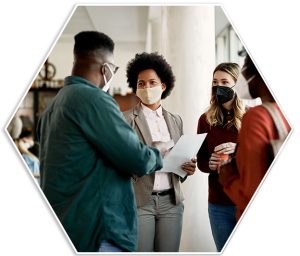 What followed was an eye-opener and something quite positive. Campus closures revealed and reinforced the high value of being together—of connectedness. Yes, it’s a real dichotomy. An article in The Atlantic, “America Will Sacrifice Anything for the College Experience,” stated that “undergraduates care more about experiencing campus life…ask college graduates what mattered most and it’s their long-lived friendships that come first to mind.” Use this to great advantage in the way you plan for and create space and place. Place matters! In addition, The Chronicle of Higher Education monograph, Rethinking Campus Spaces: How to Prepare for the Future of Learning and Work, elaborated:
What followed was an eye-opener and something quite positive. Campus closures revealed and reinforced the high value of being together—of connectedness. Yes, it’s a real dichotomy. An article in The Atlantic, “America Will Sacrifice Anything for the College Experience,” stated that “undergraduates care more about experiencing campus life…ask college graduates what mattered most and it’s their long-lived friendships that come first to mind.” Use this to great advantage in the way you plan for and create space and place. Place matters! In addition, The Chronicle of Higher Education monograph, Rethinking Campus Spaces: How to Prepare for the Future of Learning and Work, elaborated:
Expect colleges both to have people on campus less frequently in the future and to be more thoughtful about how people move through physical spaces when they are there. Institutions will also seek to maximize how much students and faculty and staff members interact whenever they meet in person … (utilizing) one of the most precious commodities on campus—space.
Our colleagues at Gordian reinforced this message in their State of Facilities in Higher Education 2021 report. Further to the point, we learned during APPA’s Town Halls that movement “outside” the classroom is possibly even more important than the classroom setting itself. Therefore, being attentive to intentionally create and further maximize student, faculty, and staff interactions—casual, informal collisions and enhanced learning neighborhoods—ensures connectedness and community.
“Community and connection with friends are what students may want most from on-campus experience.” (The Chronicle of Higher Education)
Several questions should be explored. For example, how do we shape campus spaces to create community and bring together these students? This requires increased flexibility in all ways—in buildings, people, and teaching—and increased adaptability.
Next, how can we contribute to improved “welcoming environments?” What does this mean for your institution? How do you go about it? How does it feel to your students? From our Town Halls we found that students are hungry for togetherness. We need space to enhance opportunities for accidental, informal collisions—spaces that reinforce the importance of “sense of place.” In fact, Joe Bilotta of JBA, Inc., said, “Although prospective students are initially visiting our campuses with their fingertips using technology, the deal is sealed when they see and get a feel for the campus and understand what it is like from a physical sense.”
“Spaces built around what’s most valuable about seeing one’s peers in person.” (The Chronicle of Higher Education)
Finally, what does community look like? How can “place” create that feeling and become an opportunity? Some ideas that might help include driving recruitment and retention enrollment numbers, enhancing decision-making in space design, being intentional, and using tools to enhance the students’ college experience. Again, place matters.
Theme #2: Considering the Remote/Hybrid Workplace
The success of remote/hybrid learning has now morphed into a campus-wide discussion raising more and more questions around the remote/hybrid workplace. This is not a simple problem to assess, let alone resolve, given the importance of balancing the productivity and performance of faculty and staff and correlating that to effective space utilization. Ensuring the sense of connectedness and community in the “work from home” (WFH) environment can be tricky.
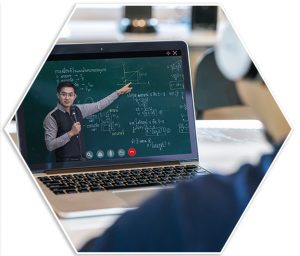 Although people have expressed the need for and benefit of WFH focus time, they also miss being “disturbed” by the informal, drop-in conversations, random chats, and hallway connections that happen in the work environment. This increases the importance of and need for physical space and the relationships that space creates. The needs of our employees are no different than those of our students! Then add the concerns and debate over work/life balance. Frankly, people are emotionally exhausted from these changes and the uncertainties of the pandemic. The world of work has changed and so have employee/employer relationships.
Although people have expressed the need for and benefit of WFH focus time, they also miss being “disturbed” by the informal, drop-in conversations, random chats, and hallway connections that happen in the work environment. This increases the importance of and need for physical space and the relationships that space creates. The needs of our employees are no different than those of our students! Then add the concerns and debate over work/life balance. Frankly, people are emotionally exhausted from these changes and the uncertainties of the pandemic. The world of work has changed and so have employee/employer relationships.
A sampling of some questions highlighted by our Town Hall panelists could help our thinking:
- Will remote/hybrid work environments allow us to recapture and reassign significant amounts of space?
- How much space savings will we actually accrue?
- How will these spaces help departments and teams encourage a sense of inclusion, thereby reducing feelings of isolation?
Besides the myriad questions that arise from the WFH issue, institutions need good data, analytics, and insights from facilities professionals so that data can be turned into information with which to make educated and informed institutional decisions. There is so much more work to do on this front to frame its value for each institution.
Theme #3: Balancing Building Productivity and Human Performance
Emmanuel Daniel, Microsoft’s director of digital transformation for smart buildings and campuses, said, “Innovation cannot be measured; it has to be stirred.” Physical space, bringing people together for that shared experience, is critical to boosting innovation. Hence, the focus on workplace/office experiences you cannot get at home. This requires data and other infrastructure insights to personalize the services needed to enhance those experiences. A focus on smart building technologies can assist in that data capture.
First, smart building technologies aid in our focus on campus energy savings and building productivity. These technologies have also proven invaluable within operations and maintenance, moving us from less reactive work to more planned and predictive work that helps streamline our work management service delivery systems. All of them are used to drive down costs. Enhancing the quality of occupants’ contributions in terms of building occupant productivity, health, and human performance should also be a driver in this equation, but these benchmarks remain elusive and difficult to measure quantitatively. Smart technologies can bring us closer to bridging that measurement gap. Smart technologies are not just cool additional bells and whistles. They are invaluable tools for the predictive analytics needed to make good business decisions. The business case can and should be made for the utilization of smart technologies, and healthy buildings may just be one way to incentivize need and use.
Gordian’s monograph stated, “Short-term responses to the coronavirus had the unintended consequence of establishing a new floor for what constitutes a healthy space.” In fact, the indoor environment is a key determinant of our occupants’ safety, health, and productivity. Buildings are central to our lives and livelihoods. We spend 90% of our time in them. People and their performance are critical elements in the total cost of operating our buildings and of bringing balance to human health and performance. Facilities professionals have a huge impact on our collective health and well-being, and there is quantitative research to support that statement.
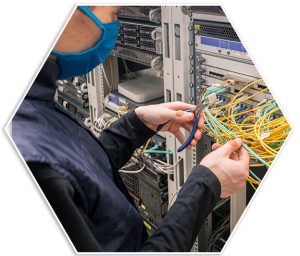 Finally, building and occupant health can be aided by smart technologies, which is just one aspect of their value revealed by the coronavirus. To my mind, smart building technologies form the umbrella to many other pathways and benefits, of which healthy buildings is one. Ask yourself, what data could assist in measuring building/environmental health? This is so important that APPA’s Board of Directors recently approved a project task force for the Healthy, Smart Building Score Initiative. We look forward to more progress on this topic by some terrific volunteers and business partners.
Finally, building and occupant health can be aided by smart technologies, which is just one aspect of their value revealed by the coronavirus. To my mind, smart building technologies form the umbrella to many other pathways and benefits, of which healthy buildings is one. Ask yourself, what data could assist in measuring building/environmental health? This is so important that APPA’s Board of Directors recently approved a project task force for the Healthy, Smart Building Score Initiative. We look forward to more progress on this topic by some terrific volunteers and business partners.
Theme #4: Examining Reskilling
For sure, we have an aging workforce and are having a difficult time recruiting and retaining staff for the skilled trades; we are experiencing a dearth of incoming skilled trades workers from our local communities. As a result, some institutions have established apprenticeship programs to develop their own talent.
Yet, there is ongoing professionalization of staff at every level, especially now in the skilled trades where smart technology systems are exceedingly complicated and sophisticated. Adding increased technology system skills has changed the very nature of some of our trades from mechanics to technicians to artificial intelligence (AI) engineers and beyond. Plus, we have increasing data needs stemming from the utilization of smart technologies. Yet, we are still living in a world that is data-rich and information-poor. Why? It’s a conundrum I cannot answer. However, this change is coming whether we like it or not and will occur in three to five years (maybe sooner). Using a skills needs assessment, we can position ourselves more effectively to meet these coming needs.
In addition, we must focus on enhancing everyone’s soft skills, those uniquely human skills such as listening skills, attention to detail and attentiveness, effective communication, critical thinking, interpersonal skills, and active learning/learning new skills. These stem from the top skills employers seek in candidates today.
As Michael Hansen, CEO of Cengage, said, “We must not underestimate the power of the people factor in the workforce. Technology and automation will continue to change and replace jobs, but there are skills that cannot be automated, such as the ability to think critically or problem solve … For those willing to hone their uniquely ‘human skills,’ there is opportunity … While employers anticipate that computer and tech skills will be among the most coveted in the next five years, many human skills, such as critical thinking, communication, and the ability to learn new skills will remain important” (Cengage press release, January 16, 2019).
Theme #5: Enhancing Facilities Professionals Relevance
I’m encouraged that the pandemic’s forced disruption put facilities professionals in the forefront of the need to deliver a safe, healthy, and productive environment for the entire community. And, my word, did you rock! Consider Past APPA President Jim Jackson’s comment in the Gordian monograph, “Fifteen years ago, facility leaders were begging to have a seat at the senior leader table. In many institutions, due to COVID, technology and data, many have found themselves sitting at the head of the table.” Then, during a Town Hall concerning the remote/hybrid workplace, Joe Bilotta commented, “The facilities department and the academic deans are now best friends.”
This says a lot about changing relationships, the need for your advice and guidance, the time needed for facilities professionals to proactively prepare options, and taking advantage as the university shifts. This changes how we plan for our space and facilities and the potential shift of space back to the academic community for repurposing.
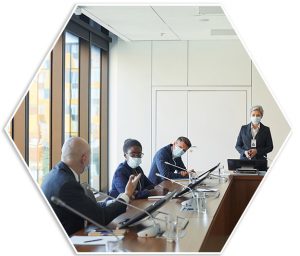 To that end, facilities professionals can help create new tools and planning metrics or templates along with space and financial impacts as we change the way we do business. We can play a big role by showing options, possibilities, and opening minds to the space ramifications based on operational plans and models. Silos are down and people are looking for advice and guidance, so we need to be both assertive and collaborative. Furthermore, we can use the immense amounts of data and information we collect to enhance our credibility and help drive institutional decision making.
To that end, facilities professionals can help create new tools and planning metrics or templates along with space and financial impacts as we change the way we do business. We can play a big role by showing options, possibilities, and opening minds to the space ramifications based on operational plans and models. Silos are down and people are looking for advice and guidance, so we need to be both assertive and collaborative. Furthermore, we can use the immense amounts of data and information we collect to enhance our credibility and help drive institutional decision making.
Here lies your opportunity to lead in this moment instead of waiting for guidance from academics. Use lessons gleaned from one another, but also seek to benchmark other industry sectors to address possible pros, cons, and potential pitfalls. The need for and pace of this past year actually bodes well for movement on those long-term planning issues. There are metrics, models, templates, and questions you can develop and use to drive discussions that are necessary for the viability of the entire institution, not just facilities. All this requires speed and agility.
There’s a relevant analogy from Widener University, “Build with Legos,” about being agile in a rapidly changing environment:
Widener University offered an analogy for all higher ed leaders to consider in order to maintain that sense of agility when making strategic decisions: are we ‘pouring concrete,’ with cost-intensive, time-intensive, more permanent structures like new buildings on campus, or are we ‘building with Lego blocks,’ with measures that can easily be taken apart or adjusted if necessary when the situation demands? —2021 Higher Ed Practices for Presidents and Chiefs of Staff | EAB
Now, that’s flexibility and adaptability!
Theme #6: Collaborating Is Key
What we did with our enhanced relevance and putting our “essential employees” on the map resulted in new communication needs and strategies and broke down organizational silos all across the campus community. Facilities professionals demonstrated high value and effective leadership through meaningful collaboration.
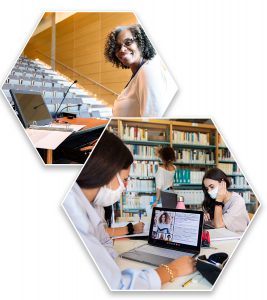 Now, how we assist our institutions through this next phase of recovery will determine our continued relevance! Facilities professionals cannot do this alone; financial officers cannot do this alone. The old saying “It takes a village” is apt. We can drive that discussion with solid data, given our newfound relevance. We must provide quality data and information necessary to drive excellent discussions and outcomes.
Now, how we assist our institutions through this next phase of recovery will determine our continued relevance! Facilities professionals cannot do this alone; financial officers cannot do this alone. The old saying “It takes a village” is apt. We can drive that discussion with solid data, given our newfound relevance. We must provide quality data and information necessary to drive excellent discussions and outcomes.
Microsoft’s CEO, Satya Nadella, said, “A digital technology should not be a substitute for human connection. Digital technology should help human connection when there are constraints of space and time.” Therefore, we need space for collaboration and interaction to enhance opportunities for the accidental, informal collisions that are so important for student interactions with faculty and staff, but also (we found quite clearly) for staff interactions that can help to foment new ideas and be more productive. We can’t create those without extensive, cross-campus collaboration.
Conclusion
Across all my opportunistic themes, three action words are embedded: flexibility, adaptability, and resiliency, which Harvard Business Review defines as “the ability to recover from setbacks, adapt well to change, and keep going in the face of adversity.” All three are key ingredients to our collective success.
However, let’s not ignore the level of “disruption” we face. This quote from Jack Welch puts that in full relief: “If the rate of change on the outside [of the organization] exceeds the rate of change on the inside, the end is near.” This quote haunts me, as I believe it heightens the sense of urgency before us. Now consider Einstein’s statement: “If I had an hour to solve a problem, I’d spend 55 minutes thinking about the problem and 5 minutes thinking about solutions.”
Frankly, we’ve been thinking about and considering these problems for a long, long time. Coupled with the level of disruption we face, now is the time to proactively seek and identify solutions to truly take advantage of this rare moment as an opportunity—or more aptly, a “change point”—that we can seize to our advantage. Complacency is not an option! What Larry Summers stated during the Great Recession holds true now: “A good rule of thumb for many things in life holds that things take longer to happen than you think they will, and then happen faster than you thought they could.” Our world has changed, is changing, and will continue to change. Let’s make it a better world.
P.S. My perspectives are that of a strategist, so any lack in the technical aspects is all mine. I hope you’ll connect with me after reading this article to provide your thoughts, ideas, and perspectives.
Lander Medlin is APPA’s president and CEO and can be reached at [email protected].



